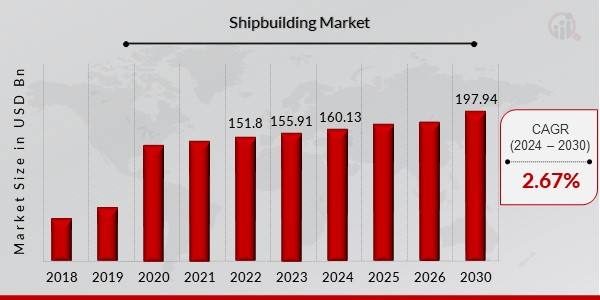Shipbuilding Market Overview: Evaluating Size, Share, and Growth Trajectory to 2030

Shipbuilding Market Outlook
The vast oceans, the arteries of global trade, rely on a robust shipbuilding industry. As the world’s economy continues to evolve, the demand for vessels of all kinds remains consistent, driving the shipbuilding market forward. Recent data indicates a substantial market size, valued at USD 155.91 billion in 2023, and projections suggest a steady growth trajectory, reaching USD 197.94 billion by 2030, with a CAGR of 2.67%. This guest post will explore the key factors influencing this market, analyse its segments, and delve into the future trends shaping its course.
Anchoring Growth: Key Drivers of the Shipbuilding Market
Several forces are contributing to the steady expansion of the shipbuilding market
- Global Trade Expansion: The increasing volume of international trade necessitates a larger and more efficient fleet of cargo vessels. Container ships, bulk carriers, and tankers are crucial for transporting goods across continents, driving demand in this segment.
- Growing Energy Demand: The transportation of oil and gas remains a vital component of the energy sector. The need for specialized tankers and offshore support vessels continues to bolster the shipbuilding market.
- Increased Naval Expenditure: Geopolitical tensions and the need for maritime security are driving governments worldwide to invest in naval vessels, including warships, submarines, and patrol boats.
- Rise in Cruise Tourism: The growing popularity of cruise vacations is propelling the demand for larger and more luxurious cruise ships, contributing significantly to the market’s growth.
- Offshore Wind Energy Development: The expansion of offshore wind farms requires specialized vessels for installation, maintenance, and support, creating new opportunities for shipbuilders.
- Technological Advancements: Innovations in shipbuilding technology, such as automation, digitalization, and the use of advanced materials, are improving efficiency and reducing costs, making shipbuilding more attractive.
Segmenting the Seas: Market Diversification
The shipbuilding market is diverse, encompassing various vessel types and applications:
- Commercial Vessels: This segment includes cargo ships (container ships, bulk carriers, tankers), passenger ships (cruise ships, ferries), and offshore support vessels.
Get a Quote – Request a price quote for the report or specific research services.
- Naval Vessels: This segment comprises warships (aircraft carriers, destroyers, frigates), submarines, and patrol boats.
- Specialized Vessels: This segment includes vessels for dredging, research, and other specialized applications.
- Ship Repair and Maintenance: This segment involves the repair, maintenance, and conversion of existing vessels, providing a vital service to the maritime industry.
Navigating Future Trends: Innovations and Challenges
The shipbuilding industry is undergoing a transformation, driven by technological advancements and evolving market demands:
- Sustainable Shipbuilding: The industry is increasingly focusing on developing environmentally friendly vessels, incorporating technologies such as alternative fuels (LNG, hydrogen), hybrid propulsion systems, and emission reduction technologies.
- Digitalization and Automation: The adoption of digital technologies, such as 3D printing, virtual reality, and automation, is improving efficiency and productivity in shipbuilding processes.
- Autonomous Shipping: The development of autonomous and semi-autonomous vessels promises to revolutionize the maritime industry, offering increased efficiency and safety.
- Advanced Materials: The use of lightweight and high-strength materials, such as composites and advanced alloys, is improving vessel performance and reducing fuel consumption.
- Cybersecurity: As ships become more connected, cybersecurity is becoming increasingly important to protect against cyberattacks and ensure the safety of maritime operations.
However, the industry also faces several challenges:
- Fluctuations in Raw Material Prices: The cost of steel and other raw materials can significantly impact shipbuilding costs.
- Skilled Labor Shortages: The industry is facing a shortage of skilled workers, particularly in specialized trades.
- Regulatory Compliance: Shipbuilders must comply with stringent international regulations regarding safety and environmental protection.
- Geopolitical Instability: Global political events can impact trade flows and naval expenditures, affecting the shipbuilding market.
Charting a Course for Growth
Despite the challenges, the shipbuilding market remains poised for steady growth. The increasing demand for efficient and sustainable vessels, coupled with technological advancements, will continue to drive the industry forward. Shipbuilders that embrace innovation, adopt sustainable practices, and invest in their workforce will be well-positioned to navigate the waves of change and capitalize on the opportunities that lie ahead.
The shipbuilding industry, though traditional, is adapting to modern demands. By focusing on green technologies, and automation, it is setting a course for continued success. The growth, though moderate, is stable, and essential for the smooth operation of global commerce.